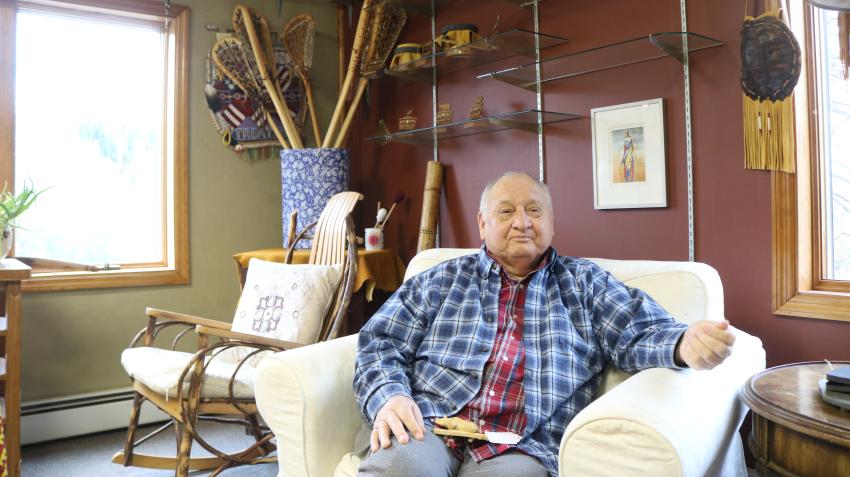According to the Mohawk, an Indigenous tribe based in North America, the Earth as we know it used to rest on the back of a gigantic turtle – and after the continents separated, North America was known as “Turtle Island”. While the inhabitants of the Island, be it people, other animals or plants, basically live in harmony, if balance was not maintained in the environment, the “creator” would help recalibrate.
Tom Porter, a Mohawk spiritual leader of a community based along the St. Lawrence and Grasse Rivers, which transverse Upstate New York in the United States as well as Ontario and Quebec in Canada, first noticed the change in the early 1980s through a radio programme he heard on the way to his daily fishing routine. “All the Mohawk people, we advise you not to eat fish. Especially women who are nursing their babies or are pregnant. It’s toxic, it’s polluted. People who are not pregnant nor nursing can eat fish, but only once a week.” The toxic pollutants came from industrial waste, which was released into the rivers by manufacturing companies nearby.
Porter, along with his community members, immediately began connecting the pollutants to unexplained health effects in their community: severe birth defects, a higher-than-usual cancer rate, and a shorter lifespan among clan elders. These observations were brought to the attention of governments in Canada and the United States, which led to studies on the soil, riverbed, and farmland in their reservation to determine how large of an effect the polychlorinated biphenyls, or PCBs, had on the community.
Despite extensive research, key information was still missing then to pinpoint how PCBs had made their way into living animals. To answer that question, several Mohawk students were sent to intern with scientists at New York State laboratories. Amongst them was Dr. Mary Arquette, at the time a student and now a veterinarian and immunotoxicologist. She ran a sample test on a snapping turtle at the laboratory, which tested at 835 parts per million of PCBs, while the allowable limit of consumable fish caps at 2 parts per million today.
The turtle, something so central to the Mohawk’s creation myth, was becoming sick and dying because of toxic pollution. This discovery made many in the community feel that the underpinnings of their earth were coming apart. Dr. Arquette recalled, “In our creation story Turtle Island is Earth, and so the turtle [finding] was quite significant. The whole core of North America is polluted, and someone is culturally screaming at you ‘This is important! Do something!’”
The collaboration with the academic community went even further, with Porter, Dr. Arquette and a dedicated group of Mohawks and supporting scientists establishing the Akwesasne Task Force on the Environment in 1987. The help from scientists was crucial in their fight to protect their environment, for the community’s actions needed to be supplemented with facts and research. Porter looked to scientists to “tell the truth. And not only in small amounts, but to tell the world how bad it is where we live”.
The Akwesasne Task Force for the Environment continually fought for the truth and cleanup of their rivers and surrounding lands through participating in academic conferences, protests, and intergovernmental meetings. Back then, no one had expected that their fight would go on for thirty years. The struggle to get companies to clean up their own pollution was far from linear, with standards of “clean” deviating between governments and responsible companies that wanted to spend the smallest amount possible on the cleanup.
Much of the last thirty years were spent limiting leakage and containing pollutants in an effort to clean up the contaminated land and water. The toxic clean-up was completed in November 2021, and the project moved onto its next phase: ecological restoration. The standard method for cleaning up the PCBs is to cover them with an impermeable cap, which helps in limiting their exposure to the environment.
This means that most of the industrial pollutants released still remain in the St. Lawrence and Grasse Rivers. Over 48 acres (19 hectares) of land and water have been restored so far, but a fishing advisory will remain in place for likely hundreds of years. In the Mohawk community, young people’s blood still contain twice the national average of PCBs. Fish cannot be safely consumed. Cancer like lymphoma and melanoma is increasingly prevalent.
Nevertheless, advocacy efforts by the Mohawk nation for the cleanup of PCB, with the help of the academic community, have limited the exposure of future generations to the remaining pollutants. Kay Olan, a retired teacher and Mohawk storyteller, says “In our original instructions we are supposed to think not just of ourselves, but also think of the impact of our work and actions on the seven generations to come. In so doing, that will help us make good decisions in relation to each other and with the natural world.”
When Tom Porter first heard the news about the pollution, he immediately pulled his fishing nets from the river and let them rot. He still hasn’t returned to his favourite fishing site. For this year’s International Mother Earth Day on 22 April, take a minute to consider the legacy you want to leave behind for the following seven generations: a healthy or poisoned Mother Earth?

